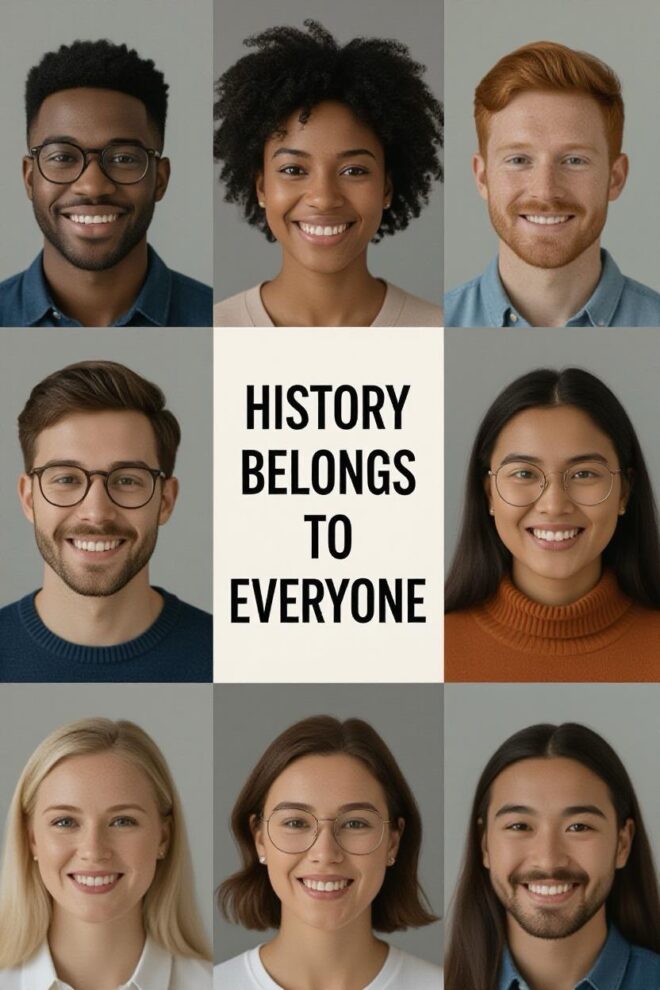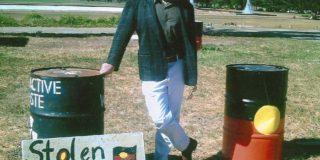
The past is truly a foreign country, as MaryLou Kayser reflects; a realm where values, beliefs, and ways of life diverge profoundly from our own. Understanding history requires more than facts; it demands empathy for customs and mindsets that shaped societies long gone. In this journey through time, we encounter a world both familiar and alien, reminding us how much humanity evolves.
Introduction
The question of “who owns the past” is not merely an academic inquiry but a profound philosophical and political challenge that interrogates how societies construct their identities, narratives, and power structures. History is not a static artefact owned by any single group; rather, it is a collective inheritance shaped by diverse voices, experiences, and migrations. This essay argues that the past belongs to humanity as a whole, not to any dominant ethnic or religious faction. Central to this discussion is the deconstruction of white supremacy, which we posit as nothing more than a fairytale, a fabricated narrative with tenuous connections to historical reality, perpetuated to justify colonialism, exploitation, and exclusion.
Focusing on Australia as a case study, we challenge the outdated notion of it as a “white Christian” country. Australia is fundamentally a land of immigrants, where waves of arrivals from across the globe have woven a rich tapestry of cultures, religions, and ethnicities. White Christian males, far from being the demographic core, constitute only a small percentage of the population in this diverse mosaic. Drawing on historical analysis, demographic data, and philosophical debates, this essay will explore these themes substantiating claims with evidence from reliable sources.
To structure our argument: First, we delve into the concept of owning the past, examining how historical narratives are contested. Second, we dismantle white supremacy as a myth disconnected from empirical history. Third, we trace Australia’s immigrant roots and current demographics to illustrate its non-white, non-Christian character. Finally, we conclude by advocating for a shared ownership of history that embraces inclusivity.
Who Owns the Past? A Contested Heritage
The debate over “who owns the past” has raged in academic, cultural, and political spheres, often centring on artefacts, narratives, and interpretations of history. As one source notes, this question arises in contexts like museum collections and repatriation demands, where institutions like the British Museum grapple with claims from source countries. The past is not a commodity to be possessed by the victors of history but a shared resource that informs present identities and future trajectories.
Philosophically, owning the past implies control over its interpretation. In the words of scholars, it pits “scholars against collectors” and raises questions about stolen artefacts and cultural heritage. For instance, the repatriation of artefacts from colonial-era acquisitions challenges the notion that Western museums “own” global history. This debate extends to narratives: Who gets to write history? Traditional historiography, dominated by European perspectives, has often marginalised indigenous, African, Asian, and other non-Western voices.
In Australia, this question is acute due to its colonial history. Indigenous Australians, whose presence dates back 60,000-80,000 years, assert ownership over a past disrupted by British invasion in 1788. The arrival of convicts, free settlers, and later immigrants from Europe, Asia, and beyond complicates claims of singular ownership. The past here is layered: Aboriginal Dreamtime stories coexist with colonial records and migrant oral histories.
Critics argue that “owning the past” perpetuates power imbalances. For example, the “Lost Cause” myth in the U.S. rewrote Civil War history to downplay slavery, much like how Australian history has sometimes glossed over Indigenous dispossession. True ownership requires democratising history – through inclusive education, repatriation, and multicultural storytelling. No group, especially not a minority like white Christian males, can monopolise it.
This leads to the myth of white supremacy, which falsely claims historical ownership based on racial superiority.
White Supremacy as a Fairytale: Disconnected from Historical Reality
White supremacy is often portrayed as an immutable historical force, but upon scrutiny, it reveals itself as a constructed fairytale, a narrative invented to rationalise exploitation, with scant basis in empirical reality. Rooted in pseudoscience like “scientific racism”, it emerged during the Enlightenment and peaked in the colonial era, but its foundations are shaky myths rather than facts.
Historically, white supremacy justified slavery, colonialism, and segregation by positing Europeans as inherently superior. Yet, this ignores the advanced civilisations predating European dominance: African empires like Mali, Asian innovations in China and India, and Indigenous Australian societies with sophisticated land management. The “myth of white supremacy” is critiqued as a tool to perpetuate dominance, not reflect reality.
Consider the transatlantic slave trade: While Europeans profited, the narrative of racial superiority was a post-hoc justification. African societies were not “primitive”; they had complex economies disrupted by European intervention. Similarly, colonialism in Australia framed Aboriginal people as “inferior,” enabling land theft, but genetic and archaeological evidence shows their deep adaptation and knowledge systems far outstripping colonial myths.
Critics like Jeffrey Sachs argue that Western superiority was temporary, fuelled by geographic advantages (e.g., Guns, Germs, and Steel theory), not intrinsic traits. The current rise of non-Western powers like China debunks the supremacy fairytale, exposing it as resentment toward shifting global dynamics.
In modern discourse, white supremacy is invoked as a bogeyman, but data shows it’s a declining ideology. Social media posts highlight its mythical status, with users calling it a “myth created to spread hate.” It’s disconnected from reality because history is replete with interracial collaborations, migrations, and hybrid cultures. White supremacy’s “fairytale” quality lies in its oversimplification: It ignores how “whiteness” itself is a social construct, varying by era and region (e.g., Irish and Italians once excluded from “white” in the U.S.).
In Australia, this myth manifested in the White Australia Policy (1901-1973), restricting non-European immigration to preserve “racial purity.” Yet, even then, it was a policy, not a historical inevitability – overturned by multiculturalism. Today, it’s a relic, with little connection to the diverse reality.
Substantiating this: White supremacy has been linked to flawed ideas like Max Weber’s Protestant ethic, but global economic shifts prove it’s baseless. It’s a story told by the powerful to maintain control, but history’s reality is pluralism.
Australia: Neither White Nor Christian – A Land of Immigrants
Australia’s identity as a “white Christian” nation is a persistent myth, rooted in colonial propaganda but contradicted by history and demographics. From its earliest human settlement to modern times, Australia has been a land of immigrants, with white Christian males forming only a small fraction of the population.
Human migration to Australia began around 80,000 years ago with Aboriginal ancestors from Southeast Asia. European arrival in 1788 marked the start of mass immigration: Convicts (mostly British), free settlers, and gold rush seekers from China and elsewhere. By the 19th century, non-European migrants were integral, despite restrictive policies.
Post-WWII, Australia welcomed displaced Europeans, then Asians after the White Australia Policy’s dismantling in 1973. Today, 27.6% of Australians are born overseas, from over 200 countries. This immigrant foundation undermines claims of a monolithic “white” identity.
Demographically, Australia is not “white”. The 2021 census shows no single “white” category; instead, ancestries include English (33%), Australian (29.9% – largely European but mixed), Chinese (5.5%), Indian (3.1%), and Filipino (1.7%). While European descent dominates (around 75%), this includes diverse groups like Italians and Greeks, not a uniform “white” bloc. Indigenous Australians (3.2%) and Asian Australians (17%) further diversify.
Religiously, Australia is not a Christian-majority nation in the absolute sense. The 2021 census reveals 43.9% identify as Christian (down from 52.1% in 2016), with 38.9% “no religion” – the fastest-growing group. Other faiths: Islam (3.2%), Hinduism (2.7%), Buddhism (2.4%). Christianity’s decline reflects secularisation and immigration from non-Christian regions.
Combining these: White Christian males are a minority. Assuming ~75% European descent, ~44% Christian, and ~49% male, with overlaps (not all Europeans are Christian; many are secular), estimates place them at 15-20% of the population – not “small” but certainly not dominant in a pluralistic society. Social media discussions echo this, noting demographic shifts away from “white Christian” norms.
Australia’s multiculturalism policy since the 1970s celebrates this diversity, with cities like Melbourne and Sydney as global melting pots. Immigrants drive economy and culture, from Vietnamese pho to Indian festivals. The myth of a “white Christian” Australia ignores this reality, perpetuating exclusion.
Historically, waves of immigration – Irish Catholics in the 1800s, post-war Italians, 1970s Vietnamese refugees, recent African and Middle Eastern arrivals – have reshaped the nation. Indigenous perspectives remind us that all non-Aboriginal Australians are immigrants or descendants thereof.
In essence, Australia exemplifies shared historical ownership: A land where the past is co-authored by immigrants, not owned by a shrinking white Christian male demographic.
Intersections: White Supremacy, Ownership, and Australian Identity
Linking back, white supremacy’s fairytale in Australia manifests in attempts to “own” the past as exclusively white Christian. Policies like the Stolen Generations (removing Indigenous children) and immigration restrictions were justified by racial myths. Yet, these are disconnected from reality: Australia’s prosperity stems from immigrant labour, not racial purity. Demographic trends project further diversity; by 2050, non-European ancestries will rise, Christianity will dip below 40%. White Christian males, already a small percentage relatively, will diminish in influence.
Whilst debates over statues and history curricula highlight ownership tensions, removing colonial figures isn’t erasing history, but democratising it, allowing marginalised voices to claim their share. As in Edinburgh University’s inquiry into its racist past, acknowledging complicity in supremacy myths is key to shared ownership. In Australia, reconciliation with Indigenous peoples and multicultural policies advance this. This shift debunks supremacy. History shows resilience through diversity, not homogeneity.
Extended Analysis: Historical Case Studies and Philosophical Underpinnings
To deepen our argument, consider case studies. The British colonisation of Australia in 1788 was framed as “terra nullius” – empty land – ignoring Indigenous ownership. This myth enabled dispossession, but archaeological evidence proves Aboriginal societies’ sophistication, owning the land for millennia.
White supremacy’s asserts a disconnection, claiming European innovation as superior, but gunpowder (Chinese), algebra (Arabic), and agriculture (global) predate it. The “fairytale” is evident in pseudohistory like Aryan supremacy myths, refuted by genetics.
In Australia, immigrant contributions cannot be ignored. Chinese gold miners built infrastructure, Italian post-war labourers boosted manufacturing. Today, Indian tech workers and Muslim entrepreneurs enrich the economy. White Christian males, while relatively recently historically privileged, are now a demographic sliver amid this flux. As thinkers such as Foucault argue, history is a power discourse; owning it means controlling narratives. Inclusive approaches, like community-led museums, redistribute ownership.
Today, challenges to white supremacy myths include rising anti-racism movements and demographic shifts. In Australia, “no religion” at 39% signals secularism; ethnic diversity counters “white” dominance. However, a backlash persists. Far-right groups cling to supremacy fairytales. Social media amplifies debates, with posts decrying it as a “myth. “Australia’s skilled migration policies prioritise diversity, further diluting white Christian male percentages. Owning the past collectively means education reforms that teach a multicultural history, not Eurocentric tales.
Broader Global Context
Globally, similar dynamics: US debates over critical race theory challenge supremacy myths. Europe’s colonial legacies fuel repatriation calls Australia mirrors this: As an immigrant land, its past is global, not parochial. White Christian males “small percentage” (estimated 15-20%) underscores this: They can’t claim ownership in a nation of 25 million where diversity reigns.
Critics may argue Australia remains a “white-majority” with Christian heritage. But “white” is vague; European descent includes non-Christians. Christianity’s plurality doesn’t make it “Christian.” Supremacy isn’t a myth? Historical atrocities exist, but the ideology’s “inevitability” is the fairytale – it’s constructed, not natural and modern ethics demand that demand a more honest sharing of history.
In-Depth Demographic Breakdown – data
Delving deeper, the 2021 Australian census shows
- males 12.4 million (49%)
- Christians 11.1 million (43.9%)
- European ancestry ~19 million (75%)
- Intersecting: White Christians ~8-9 million; males ~4-4.5 million (~16-18% of population). Small compared to total diversity.
- Immigration stats: 61,860 international visitors on census night, symbolising flux.
By 2030, projections show “no religion” at 45%, Asians 20%. White Christian males <15%. Australia evolves as immigrant beacon.
conclusion: history belong to us all
Australian narratives must require reimagining. Indigenous histories are central in this nation, not footnotes. Migrant stories are core to national identity. White supremacy is a fairytale that crumbles under scrutiny: it’s a tool for division, not truth. The past is a commons, like air – owned by all. Utilitarian views support inclusive access for societal benefit.
In Australia, this means treaties with Indigenous peoples and multicultural festivals owning shared past. Australia, as a vibrant land of immigrants, is neither white nor Christian; white Christian males are a small percentage in its diverse population. Embracing this reality fosters a just future, where history unites rather than divides. By democratising narratives, we honour the true complexity of our shared heritage.


